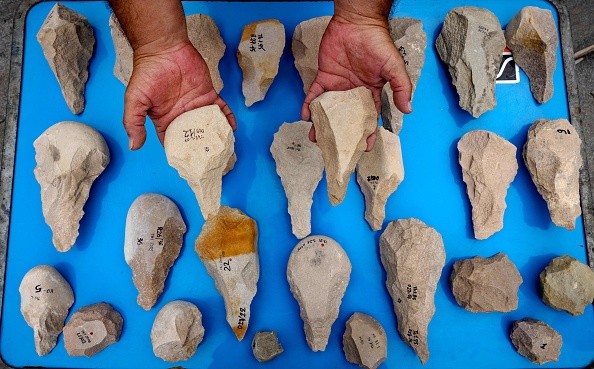Archaeologists in Kenya discovered some of the oldest stone tools ever used by ancient humans, dating back approximately 2.9 million years.
It demonstrated that the tools were used by other branches of early humans, not just Homo Sapiens' ancestors.
According to the researchers, the tools were used to butcher hippos and pound plant materials such as tubers and fruit.
Two large fossil teeth discovered at the site belonged to an extinct human cousin called Paranthropus.
Ancient stone tools found in Kenya
 (Photo : FADEL SENNA/AFP via Getty Images)
(Photo : FADEL SENNA/AFP via Getty Images)

Previously, scientists believed that Oldowan tools, a type of simple stone implement, were only used by Homo Sapiens ancestors, a grouping that includes our species and our closest relatives, as per the BBC.
However, no Homo Sapien fossils were discovered at the excavation site in Nyayanga, on Kenya's Homa Peninsula.
Instead, there were two teeth - stout molars - from the Paranthropus genus, which had ape-like and human-like characteristics, as well as 330 stone tools.
"With these tools, you can crush better than an elephant's molar and cut better than a lion's canine," said Prof Rick Potts, a senior author of the study at the Smithsonian National Museum of Natural History.
Oldowan technology was like suddenly evolving a brand new set of teeth outside your body, and it provided our forefathers with a new variety of foods on the African savannah.
The link between these Nyayanga tools and Paranthropus may reopen the debate over who created the earliest Oldowan tools.
According to anthropologist Thomas Plummer of Queens College in New York City, the lead author of the study published in the journal Science, not only Homo but other types of hominins may have processed food using Oldowan technology.
The latest discovery of Oldowan tools demonstrates that they were a significant upgrade in sophistication compared to earlier crude stone tools dating back as far as 3.3 million years, before the emergence of the Homo genus, according to researchers.
Other hominins that existed at the time included the genus Australopithecus, which is best known for the famous even older fossil "Lucy," which was discovered in northern Ethiopia in 1974.
Also read: Oldest Flaked Stone Tools Point to the Repeated Invention of Stone Tools
Stone tools
Stone tools and other artifacts provide evidence for how early humans created things, lived, interacted with their surroundings, and evolved over time, as per The Smithsonian.
Thousands of archeological sites have been excavated, studied, and dated over the last 2.6 million years.
These sites are frequently made up of accumulated debris from the making and use of stone tools.
Stone artifacts typically provide the best evidence of where and when early humans lived, their geographic dispersal, and their ability to survive in a variety of habitats because they are less susceptible to destruction than bones.
However, because multiple hominin species frequently coexisted, it can be difficult to determine which species made the tools at any given site.
Most importantly, stone tools provide evidence about the technologies, dexterity, specific types of mental skills, and innovations available to early human toolmakers.
Stone toolmaking first appeared at least 2.6 million years ago. Early humans created the most basic stone implements during the Early Stone Age.
Hammerstones, stone cores, and sharp stone flakes are included in these Oldowan toolkits.
Early humans began to make Acheulean handaxes and other large cutting tools around 1.76 million years ago.
Stone technology innovation began to pick up speed around 200,000 years ago.
Toolkits from the Middle Stone Age included points that could be hafted onto shafts to make spears, stone awls that could have been used to perforate hides, and scrapers for preparing hide, wood, and other materials.
The rate of innovation increased during the Later Stone Age.
People experimented with various raw materials (bone, ivory, antler, and stone), the level of craftsmanship increased, and different groups sought their own distinct cultural identities and adopted their own methods of making things.
Related article: Stone Tools: Oldest Yet Discovered Challenge Early Human History
© 2024 NatureWorldNews.com All rights reserved. Do not reproduce without permission.



![Climate Change is Reducing Dust Levels Worldwide as Arctic Temperature Warms [Study]](https://1471793142.rsc.cdn77.org/data/thumbs/full/70320/280/157/50/40/climate-change-is-reducing-dust-levels-worldwide-as-arctic-temperature-warms-study.jpg)
![Tsunami Hazard Zones: New US Map Shows Places at Risk of Flooding and Tsunamis Amid Rising Sea Levels [NOAA]](https://1471793142.rsc.cdn77.org/data/thumbs/full/70325/280/157/50/40/tsunami-hazard-zones-new-us-map-shows-places-at-risk-of-flooding-and-tsunamis-amid-rising-sea-levels-noaa.jpg)
